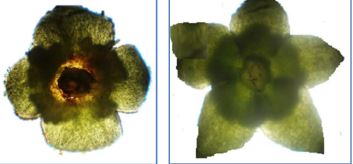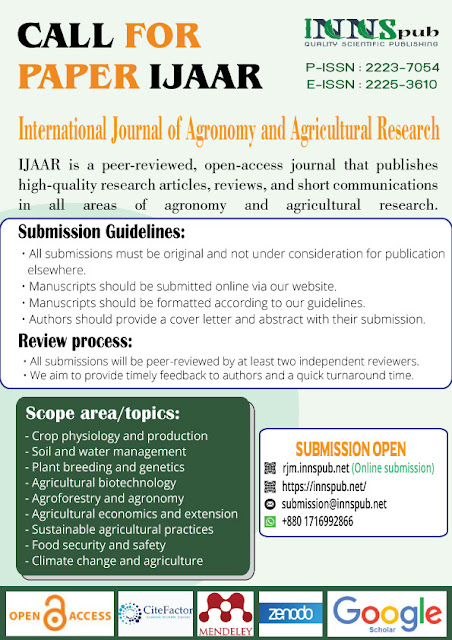Sushmita Baral, Mahbub Robbani, Jewel Howlader, Habiba Zannat Meem, Moatasim Billah and Afrina
Bilkis, from the different institute of the Bangladesh. wrote
a research article about, Baichi (Flacourtia indica) Morpho-physiological
Characteristics and Yield. entitled, Morpho-physiological characteristics and
yield of baichi (Flacourtia indica). This research paper published by the International Journal of Agronomy and Agricultural Research (IJAAR). an open access
scholarly research journal on Agronomy, under the affiliation of the International
Network For Natural Sciences | INNSpub. an open access
multidisciplinary research journal publisher.
Abstract
An investigation was
undertaken to evaluate the various morpho–physiological traits and yield
contributing characters of baichi germplasms (GP) at Patuakhali Science and
Technology University (PSTU). A number of baichi seedlings collected from
different homesteads of Patuakhali coast were conserved at PSTU Germplasm
Centre. Among the five survived germplasms (GP₁˗GP₅), two were male (GP₂ and GP₄)
and the remaining three were female (GP₁, GP₃ and GP₅). The longest leaf length
(4.45cm) was exhibited in GP₄. Maximum leaf blade width (2.83cm) was observed
in GP₅. Although all the studied germplasms flowered at age 7, however, flower
bud initiation started in male plants during the first week of February and
continued to the last week of March and in female plants, it was started during
the second week of February and continued to the mid of March. Length of flower
bud was noticed among female genotypes of GP₅ (4.67mm), GP1 (4.65mm) and
GP3 (4.62mm). Importantly, the flowers were apetalous in both male and
female cases of all five germplasms. The highest fruit set (74.83%) and the
fruit retention (80.88%) were recorded in GP₃ while the lowest fruit set
(69.51%) and fruit retention (77.16%) were noticed in GP1. GP₅ had the biggest
individual fruit size (11.24mm × 12.10mm), maximum edible portion (78.57%) and
the highest fruit yield (10.5kg/plant) while the lowest individual fruit weight
(1.19 gm) and fruit yield (8.6 10.5kg/plant) were observed in GP3. Based on the
morpho–physiological traits among the three fruiting plants it may conclude
that GP₅ was superior over other fruiting plants in relation to fruit size,
edible part, individual fruit weight and yield. Therefore, a performance
grading of the three female plants on the basis of yield can be as follows: GP₅
> GP₁ > GP₃.
Read more : Endoparasites in Sardinella lemuru and Glossogobius guiris from Caraga, Philippines |InformativeBD
Introduction
Flacourtia indica
belonging to the family Selicaceae is one of the underutilized indigenous
fruits of Bangladesh. Its common name is governor’s plum. It is locally known
as baichi or “kantabohori” that is believed to be native to much of Africa and
tropical and temperate parts of Asia. Baichi is an erect, branched, more or
less spiny shrub or small tree. This species is dioecious in nature. Baichi
produces fruit that is eaten fresh and has a pleasant rather sour taste. The
fruits make a good jelly with the seeds and skin being discarded (Tredgold,
1986). The fruit can be fermented to produce wine. Fruits are used as
appetizing, diuretic, and digestive, in jaundice and enlarged spleen. Barks are
used for the treatment of intermittent fever and are also believed to be
effective for arthritis. Roots are used in nephritic colic and gum is used in
cholera (Kirtikar and Basu, 1998, Nazneen et al., 2002). The leaves and roots
are used in herbal medicine for treatment of snakebite. Most parts of the plant
are used for cough, pneumonia, and bacterial throat infection. After child
birth among the poor the seeds is grind to powder with turmeric and rubbed all
over the body to prevent rheumatic pains from exposure to damp winds.
Pharmacological investigation includes the assessment of antihistaminic
activity of ethanolic leaf extract of baichi in experimental guinea pig model (Tyagi
et al., 2011). Gum is administered along with other ingredients in cholera. The
glistening leaves of baichi can be very attractive when the tree is planted as
an ornamental. When closely planted, it forms a close impenetrable barrier that
serves as a hedge; it tolerates frequent trimming.
People of Bangladesh are generally poorly nourished despite substantial increase of food production in the country over past few decades. Most people suffer from mal–nutrition and resultant diseases. Ceaseless effort is therefore needed to improve the nutritional status and to increase food security, particularly for the rural poor (FAO, 1992). If minor food crops are properly utilized; they may help to contribute in food security, nutrition, health, income generation and environmental services (Kunkel, 1984). Wild fruits add variations in diets improve the palatability of staple foods and provide essential vitamins, minerals, proteins, carbohydrates and fats. Wild fruits of Flacourtia jangomas add variations in diets improve the palatability of staple foods and provide protein (3.9%), carbohydrates (21%), vitamin C (218mg), calcium (175mg), potassium (158mg), phosphorous (147mg), iron (118), and magnesium (57mg) per 100 gm dry weight basis (Hossain et al., 2011; Baruah and Neog, 2016).
Sarker et al. (2015)
reported a wide range of fruit diversity in Patuakhali coast of Bangladesh, of
which most species were minor ones. Despite the many beneficial characteristics
baichi is overlooked as a fruit plant and there is no organized orcharding and
no recognized cultivars for this fruit crops. As a result baichi is in the
verge of extinction. The main reasons for the under–utilization of germplasm,
according to curators, scientists and other users of plant genetic resources,
is the lack of adequate passport, characterization, and evaluation data; people
cannot use genetic resources that lack essential information. Therefore, the
accurate documentation of information about the origin, characterization, and
performance of this germplasm is essential for effective conservation and use
(Biodiversity, 2007). Considering the problem statements, the present study was
undertaken with the objective to find out the morpho–physiologically improved
baichi germplasm (s) with higher yield contributing traits.
Reference
Baruah D, Neog B. 2016.
Botanical, phytochemical and pharmacological review of Flacourtia jangomas (lour.)
Raeusch. International Journal of Current Medical and Pharmaceutical
Research 2(3), 244-247.
Bhattacharjee TN,
Robbani M, Ali M, Mursheed N, Mehedi MNH. 2019. Biodiversity of Indigenous
Jujube Germplasm Available in Dumki Upazila. Asian Journal of Plant Science
& Research 9(1), 22-31.
Biodiversity
International. 2007. Guidelines for the development of crop descriptor
lists. Biodiversity Technical Bulletin Series, Biodiversity International,
Rome, Italy ISBN: 978–92–9043–792–1.
Food and Agriculture
Organisation (FAO) of the United Nations. 1992. Forests, Trees and Food p.
26.
Hossain MA, Sen M,
Jewel MIU, Kabir MA. 2011. Propagation of Flacourtia jangomas:
an approach towards the domestication of a wild fruit species in Bangladesh,
Dendrobiology 65, 63-71.
Kirtikar KR, Basu BD. 1998.
Indian Medicinal Plants. Ed 3rd, VolII, Singh and MP Singh Publications, India
p. 220.
Kunkel G. 1984.
Plants for human consumption. Koeltz Scientific Books, Koenigstein, Germa.
Nazneen M, Mazid MA,
Kundu JK, Bachar SC, Rashid MA, Datta BK. 2002. Protective effects of
Flacourtia indica aerial parts extracts against paracetamol induced
hepatotoxiciy in rats. J. Biol. Sci 11(2), 183-187.
Orwa C, Mutua A, Kindt
R, Jamnadass R, Anthony S. 2009. Agroforestry Database: a tree reference
and selection guide version 4.0.
Sarker CR, Robbani M,
Rahim MA, Iqbal TMT. 2015. Fruit diversity in the coastal homesteads of
Bangladesh. Journal Crop and weed 11, 95-105.
The Ayurvedic
Pharmacopoeia of India. 1999. Part I, Vol–IV, edition 1st, published by
National Institute of Science Communication, New Delhi P. 118-119.
Tredgold MH. 1986.
Food Plants of Zimbabwe. Gweru: Mambo Press p. 86.
Tyagi S, Singh M, Singh
D, Yadav I, Singh S, Mansoori MH. 2011. Anti–Asthamatic Potential of F.
indica Merr., African Journal of Basic & Applied Sciences 3(5), 201-204.
Source : Morpho-physiological characteristics and yield of baichi (Flacourtia indica)












%20in%20full.JPG)


0 comments:
Post a Comment